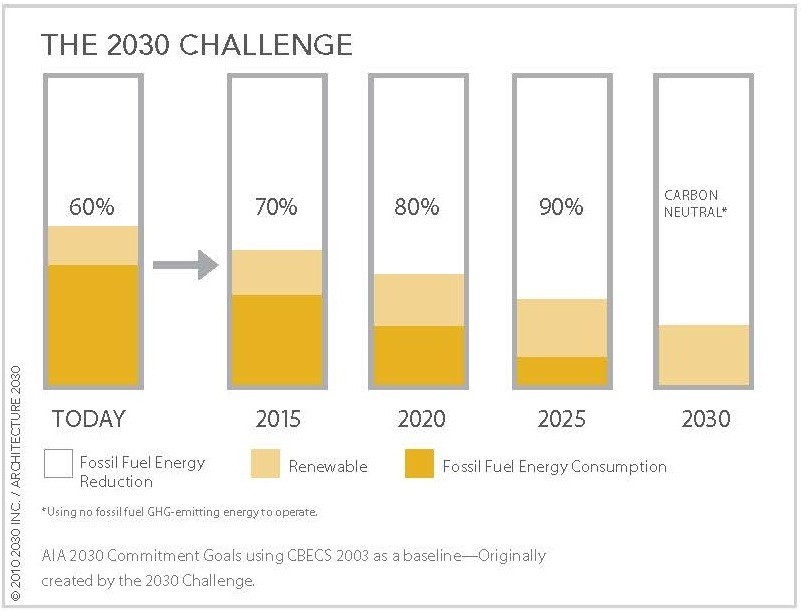This year marks the fifth anniversary of the American Institute of Architects’ effort to have architecture firms voluntarily pledge net-zero energy design for all their buildings by 2030. The AIA 2030 Commitment encourages design professionals to strategically reduce the measured energy consumption in new and existing buildings they design.
The 2030 Commitment is “an effort to get a firm’s complete body of work channeled toward carbon-neutral design,” says William D. Sturm, AIA, LEED AP, Principal at Serena Sturm Architects, Chicago, and Chair of the AIA National Committee on the Environment.
The pledge follows the 2030 Challenge issued in 2007 by Edward Mazria, FAIA, Founder and CEO of the nonprofit organization Architecture 2030, who called for the global building community to:
• Design all new buildings and major renovations to meet an energy consumption performance standard of 60% below the regional (or national) median for that building type.
• Renovate an equal amount of existing building area annually to meet an energy consumption performance standard of 60% below the regional (or national) median for that building type.
• Increase the fossil fuel reduction standard for all new buildings and major renovations in five-year increments, to reach carbon neutrality by 2030.
Last year, in its third annual 2030 Commitment progress report, the AIA called the program a roadmap for firms to transition to the ultimate goal of carbon neutrality on every project in their portfolio—not selectively targeting high performance for certain clients, or designing net-zero projects solely for clients who want it and can afford it, but achieving targeted performance goals on every project.
While there has been an increase in professional activity among medium and large firms, says Sturm, the 2030 goal may be out of reach for many smaller firms, which cite concerns over the amount of time and effort required to report on 2030 goals, as well as the lack of or access to data.
The AIA says that by the end of 2012, 241 firms had signed on to join the 2030 Commitment, with 110 of them submitting an annual progress report. These included such marquee names as CannonDesign, HOK, NBBJ, and Skidmore, Owings & Merrill, as well as midsize practices like Sturm’s own firm and Kaplan Thompson Architects, Portland, Maine.
A more recent summary on preliminary data from 2013 reporting presented at the AIA National Convention this past June showed 275 firms participating in the pledge; 79 of these had submitted data for 2013 on a total of more than 1.6 billion sf of work, reported Nootan Bharani, AIA, LEED AP BD+C, CEM, Lead Design Manager at the University of Chicago’s Place Lab, and Steve Kismohr, AIA, Senior Technical Manager at the Midwest Energy Efficiency Alliance.
The average predicted energy use intensity (EUI) reduction for 2013 from the 79 reporting firms was 34%, a slight increase from the average prediction for 2012. Around 7% of the gross square footage that was reported had reached the 2030 goal of 60% EUI reduction.
Sturm says that it is important for architecture firms to be prepared as more and more legislative bodies and standards organizations call for net-zero and carbon-neutral projects. Earlier this year California began implementing its revised building codes known collectively as Title 24, which call for all new residential and commercial construction in the state to achieve net-zero status by 2030.
Individual cities and institutions of higher learning have also embarked on 2030-type initiatives. The Royal Architectural Institute of Canada has issued a pledge to reduce greenhouse gas emissions in building construction and operation 70% by 2015, 80% by 2020, and 90% by 2025, to arrive at carbon neutrality by 2030.
William Leddy, FAIA, LEED AP, Founding Partner of Leddy Matum Stacy Architects in San Francisco and an Advisory Member of the AIA National Committee on the Environment, says “it just makes good business sense” for the architecture community to prepare for what he calls the “coming new realities” of the profession in the 21st century.
Related Stories
| Aug 22, 2013
Energy-efficient glazing technology [AIA Course]
This course discuses the latest technological advances in glazing, which make possible ever more efficient enclosures with ever greater glazed area.
| Aug 21, 2013
Why research is the ticket to successful airport wayfinding
Wayfinding is more than just signs; it requires a holistic approach based on communicating information that helps people make the right decision at the right time.
| Aug 19, 2013
Discovery of hidden asbestos complicates DFW terminal renovations
The finding of more asbestos in Terminal B than expected, and the pending merger of US Airways and the airport’s largest tenant, American Airlines, is causing construction delays on a $2.3 billion Dallas/Fort Worth Airport terminal renovation.
| Aug 19, 2013
Integration of solar panels in building skin seen as key net-zero element
Recent high-profile projects, including stadiums in Brazil for the upcoming World Cup and Summer Olympics and a bank headquarters in the U.K., reflect an effort by designers to adopt building-integrated photovoltaics, or BIPV.
| Aug 14, 2013
Green Building Report [2013 Giants 300 Report]
Building Design+Construction's rankings of the nation's largest green design and construction firms.
| Jul 29, 2013
2013 Giants 300 Report
The editors of Building Design+Construction magazine present the findings of the annual Giants 300 Report, which ranks the leading firms in the AEC industry.
| Jul 22, 2013
Transportation Facility Report [2013 Giants 300 Report]
Building Design+Construction's rankings of design and construction firms with the most revenue from airport terminals and other transportation-related facilities, as reported in the 2013 Giants 300 Report.
| Jul 19, 2013
Renovation, adaptive reuse stay strong, providing fertile ground for growth [2013 Giants 300 Report]
Increasingly, owners recognize that existing buildings represent a considerable resource in embodied energy, which can often be leveraged for lower front-end costs and a faster turnaround than new construction.
| Jul 18, 2013
Top Local Government Sector Construction Firms [2013 Giants 300 Report]
Turner, Clark Group, PCL top Building Design+Construction's 2013 ranking of the largest local government sector contractor and construction management firms in the U.S.
| Jul 18, 2013
Top Local Government Sector Engineering Firms [2013 Giants 300 Report]
STV, URS, AECOM top Building Design+Construction's 2013 ranking of the largest local government sector engineering and engineering/architecture firms in the U.S.















